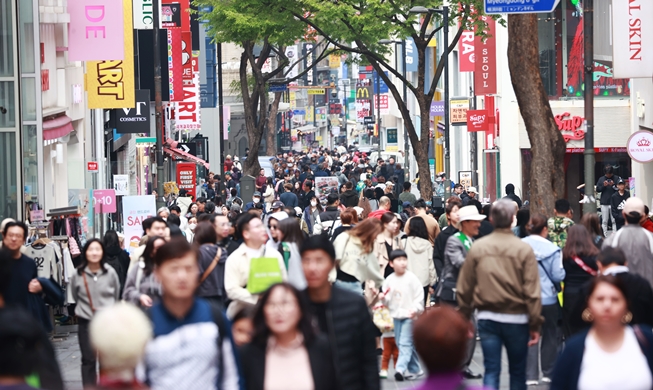-
 Korea.net's 24-hour YouTube channel
Korea.net's 24-hour YouTube channel- NEWS FOCUS
- ABOUT KOREA
- EVENTS
- RESOURCES
- GOVERNMENT
- ABOUT US
The truth behind Japan's claims made through the pamphlet called "10 Issues of Takeshima"
Claim 1
Japan says: Japan has long recognized the existence of Takeshima.
Japan's recognition is confirmed by written documents and maps, including the Kaisei Nippon Yochi Rotei Zenzu by Sekisui Nagakubo, which is the most representative cartographic work of Japan.
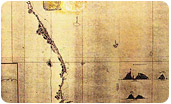 The truth:
The truth:
In the original edition of the Revised Complete Map of Japanese Lands and Roads, which is a map privately made in 1779, Ulleungdo and Dokdo are uncolored as is the Korean Peninsula. Also, the two islands are located outside the grid of Japan's longitudinal and latitudinal lines, indicating that the islands are outside of Japanese territory.
Meanwhile, there are a number of old Japanese maps published by the Japanese government, including the Chosen Tokai Kaiganzu ("A Map of the Eastern Coast of Korea," 1876), which was published by the Ministry of the Japanese Navy, that places the two islands within Korea's territory.
Since 1696, when the Tokugawa Shogunate officially banned Japanese fishermen from crossing the East Sea to Ulleungdo Island, Japanese people gradually became confused about the two islands, and not only did they refer to the islands in several different names such as Matsushima, Riyanko Island, Ranko Island and Takeshima, but also was the islands' geographic location completely forgotten in the end.
![]()
Claim 2
Japan says: There is no evidence that the ROK haslong recognized the existence of Takeshima.
There is no clear evidence to back up Korea's claim that Usando is the current island of Dokdo.
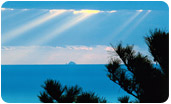 The truth:
The truth:
Korea recognized Dokdo's existence as early as when Ulleungdo was first inhabited. The records of Dokdo in Dongguk Munheon Bigo (1770) and Mangi Yoram (1808) present a particularly clear description stating: "Ulleungdo and Usando are lands of Usanguk, and Usando is the island that Japanese call Songdo (Matsushima)." No other record of this period contains a clearer statement which shows that Usando is an old name of Dokdo.
A Japanese document on the An Yong-bok incident, "One-volume Memorandum Concerning the Korean Boat that Came Alongside the Sea-shore in the 9th Year of Genroku," which was discovered in Oki Island in 2005 clearly shows that Ulleungdo and Dokdo were islands under the jurisdiction of Gangwon-do of Joseon.
![]()
Japan says: Japan used Takeshima as a stopover port en route to Utsuryo Island and as fishing ground. It thus established its sovereignty over Takeshima by the mid 17th century at the very latest.
In 1618 of the early Tokugawa period, Oya and Murakawa families in Yonago of Tottori-han received permission from the Shogunate for passage to Utsuryo Island. Thus, Takeshima was naturally used as a stopover en route to Utsuryo Island as fishing grounds.
The truth:
A permission or a license is not necessary to make passage to one's domestic islands. That Japan's Shogunate issued a government permission for passage to Utsuryo Island to Japanese merchants clearly shows that the Shogunate did not regard Ulleungdo and Dokdo as Japanese territories.
F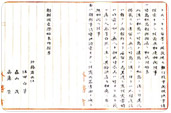 urthermore, a Japanese document Onshu Shicho Goki (Records on Observation in Oki Province), published in mid-17th century, illustrates how the Japanese did not consider Dokdo as Japanese territory: "The Oki Island marks the northwestern boundary of Japan." In 1877, the Daijokan (Japan's Grand Council of State) officially admitted on the basis of a Korea-Japan agreement concluded in the 17th century, that Dokdo was not Japan's territory: "Regarding Takeshima and the other island, it is to be understood that our country has nothing to do with them." The Ministry of Foreign Affairs of Japan also produced a similar report Chosenkoku Kosai-Shimatsu Naitansho (Confidential Inquiry into the Particulars of Korea's Relations with Japan) after a secret investigation which was conducted on the background of how Takeshima (Ulleungdo) and Matsushima (Dokdo) became annexed to Joseon, thereby publicly recognizing Matsushima (Dokdo) as Korea's territory.
urthermore, a Japanese document Onshu Shicho Goki (Records on Observation in Oki Province), published in mid-17th century, illustrates how the Japanese did not consider Dokdo as Japanese territory: "The Oki Island marks the northwestern boundary of Japan." In 1877, the Daijokan (Japan's Grand Council of State) officially admitted on the basis of a Korea-Japan agreement concluded in the 17th century, that Dokdo was not Japan's territory: "Regarding Takeshima and the other island, it is to be understood that our country has nothing to do with them." The Ministry of Foreign Affairs of Japan also produced a similar report Chosenkoku Kosai-Shimatsu Naitansho (Confidential Inquiry into the Particulars of Korea's Relations with Japan) after a secret investigation which was conducted on the background of how Takeshima (Ulleungdo) and Matsushima (Dokdo) became annexed to Joseon, thereby publicly recognizing Matsushima (Dokdo) as Korea's territory.
![]()
Japan says: At the end of the 17th century Japan prohibited passage of ships to Utsuryo Island, but not to Takeshima.
A Korea-Japan negotiation over fishing around Utsuryo in 1696 led the Shogunate to prohibit the passage of Japanese ships to Utsuryo Island, but did not ban ships to Takeshima.
The truth:
When issuing the prohibition of passage to Ulleungdo, the Tokugawa Shogunate asked the Totori-han if there were any islands attached to Tottori-han other than Ulleungdo. The Tottori-han answered that "no other islands belong to the han, including Takeshima and Matsusima," showing that neither islands were under the jurisdiction of the Tottori-han. Also as clearly explained by the subtitle of the Japanese documents "Matsuhima (Dokdo) in Takeshima (Ulleungdo)" and "Matsushima in the Vicinity of Takeshima," Dokdo was and still is widely regarded as an island attached to Ulleungdo. The prohibition of passage to Ulleungdo naturally meant the prohibition of passage to Dokdo as well.
![]()
Japan says: The deposition by Ahn Yong-Bok, on which the ROK side bases its claim, contains many points that conflict with factual evidence.
The reports by Ahn are not credible because they do not correspond to Japan's records of the incident.
The truth:
It is absolutely arrogant and totally unacceptable for Japan to assert that Korea's official records are not credible because certain facts in Korea・。・ッs records are not included in Japan's. The records of An's activities in Japan are included in several important government publications of the Joseon Dynasty, such as Sukjong Sillok, Seungjeongwon Ilgi, and Dongguk Munheon Bigo as well as Japanese texts such as Takeshima Kiji, Takeshima Tokai Yuraiki Basho Hikae, Inpu Nenpyo, and Takeshima Ko.
The Shogunate's order banning Japanese passage to Ulleungdo was issued in January 1696, but almost 8 months passed before the order was actually delivered to the residents of Yonago. Until then, the fishermen of Yonago were able to set sail to Ulleungdo. Thus, it is unsuitable to argue that An's statement is false, of seeing Japanese fishermen in Ulleungdo in May of the same year.
![]()
Claim 6
Japan says: Japan reaffirmed its intention to claim sovereignty over Takeshima by incorporating Takeshima into Shimane Prefecture in 1905.
After receiving a request from Nakai Yosaburo, a resident of Oki Island of Shimane Tottori-han, to incorporate the Lyanko Island into Japanese territory, the Japanese government reaffirmed through a Cabinet decision of its intention to claim sovereignty over the island.
The truth:
It is farfetched logic and self-contradictory for Japan to argue that they reaffirmed the incorporation of Dokdo into its territory. For such an argument to be even slightly plausible, Japan should have taken the same measures in reaffirming its sovereignty over the rest of its entire territory as well. The 1905 incorporation was initiated as part of a strategic movement to win the Russo-Japanese War. It was an illegal attempt to violate Korea's territorial sovereignty over Dokdo, which had already been fully established.
![]()
Claim 7
Japan says: In the drafting process of the Treaty of Peace with Japan, the U.S. rejected the request by the ROK that Takeshima be added to the relevant article of the Treaty as one of the areas Japan would renounce, claiming that Takeshima had been under the jurisdiction of Japan.
It is also clear from declassified US documents that Takeshima was not recognized as Korea's territory.
The truth:
The Allied Powers that include the U.S. applied Directive SCAPIN-677 and the Japanese government acknowledged after the ratification of the San Francisco Peace Treaty that Dokdo was excluded from its jurisdiction. The directive provides that Dokdo along with Ulleungdo belongs to the area which is excluded from Japan's governmental or administrative authority: "3. For the purpose of this directive, Japan is defined to include the four main islands of Japan (Hokkaido, Honshu, Kyushu and Shikoku) and the approximately 1,000 smaller adjacent islands, ... and excluding (a) Ulleung Island, Liancourt Rocks ..."
The Allied Forces' decision to exclude Dokdo from Japan's territory was part of postwar measures to implement the results from the Cairo Declaration (1943) and the Potsdam Declaration (1945).
![]()
Claim 8
Japan says: In 1952, Takeshima was designated as a bombing range for the U.S. Forces stationed in Japan, which shows that Takeshima was treated as part of the territory of Japan.
The Japan-US Joint Committee established for the purpose of implementing the Japan-US Administrative Agreement, designated Takeshima as a bombing range for the US Forces stationed in Japan
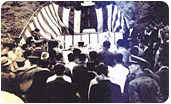 The truth:
The truth:
The continued use of Dokdo as a bombing range was result from Japan's incitation as clearly shown in the records from the Diet of Japan. The following are words exchanged between Yamamoto, a Diet member from the Shimane constituency, and Ishihara, Vice-minister of Foreign Affairs, in a Foreign Affairs committee meeting in the House of Representatives on May 23, 1952.
- Yamamoto: "As for the designation of the military practice area for the Occupation Forces, I think that if the vicinity of Takeshima is designated as a practice area, it would help Japan get confirmation of its territorial sovereignty over the island. Please tell me if that is what the Ministry of Foreign Affairs intends."
- Ishihara: "It seems that things are sought after in various ways, largely from such an idea."
Claim 9
Japan says: The ROK is illegally occupying Takeshima, against which Japan has been consistently making strong protests.
The occupation of Takeshima by Korea is an illegal occupation undertaken on absolutely no basis of international law.
The truth:
Japan has never established its territorial sovereignty over Dokdo, in any period in history. Japan's claim on the Korean islands is nothing but a unilateral and illegal attempt to infringe upon Korea's territorial sovereignty over Dokdo. Japan made once an attempt to establish sovereignty over Dokdo in 1905, but Korea had already established its sovereignty over that island. There are a number of important historical documents in both Korea and Japan, which clearly state that Dokdo is Korea's territory.
![]()
Claim 10
Japan says: Although Japan proposed to the ROK that the dispute over Takeshima be referred to the International Court of Justice, the ROK rejected this proposal.
The Japanese Government proposed to Korea to twice in 1954 and 1962 to submit the dispute to the International Court of Justice, but Korea rejected the proposal.
The truth:
A remarkable self-contradiction exists in Japan's position that while refusing to bring the issue of Diaoyutai and Senkaku Islands or the "Four Northern Territories" to the International Court of Justice, Japan asserts that the Dokdo issue alone should be solved through a decision from the court. Korea sees absolutely no reason as to why Korea should turn the matter that is all too clear to a court.
Most popular
- Final Selection of the First Cohort of Presidential Science Scholarship for Graduate Students Completed!
- Creating Our Own Neighborhood Commercial Districts
- Sub-Committee Meeting under the Presidential Advisory Council on Science & Technology Held
- MSS will drive problem-solving programs for startups through business incubator centers that have specialized capabilities
- A Guide on Generative AI and Copyright Released in English




